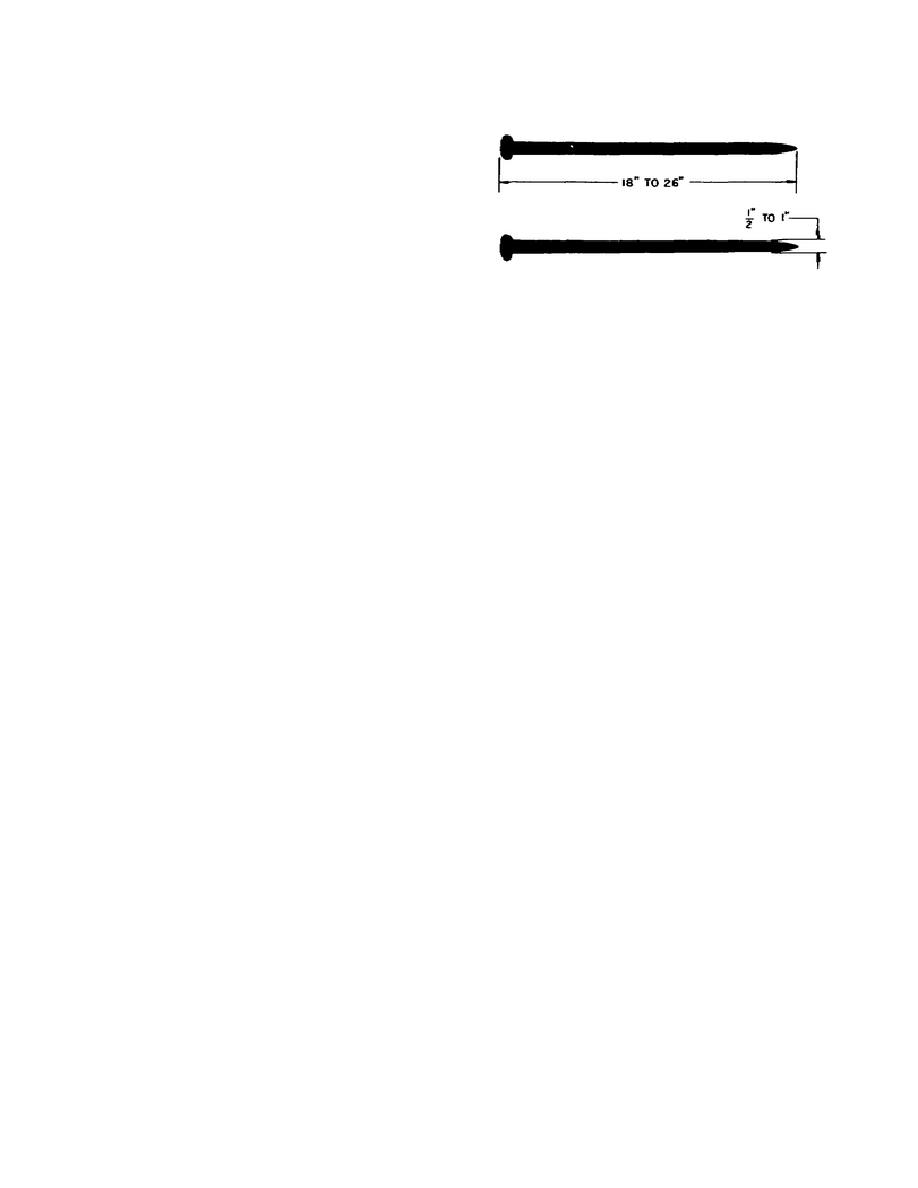
metal applications. If used for wood to metal
application, the head should be fitted to the wood
members. Metal surfaces are sometimes predrilled
and countersunk to permit the use of carriage bolts
metal to metal. Carriage bolts can be obtained from
1/4 inch diameter to 1 inch diameter, and up to 20
inches long. A common flat washer should be used
with carriage bolts between the nut and the wood
surface.
Figure 1-20. Driftpins (driftbolts).
(2) Machine bolts. Machine bolts are
made with cut National Fine or National Coarse
diameter from 1/2 to 1 inch, and in length from 18 to
threads extending in length from twice the diameter
26 inches. To use a driftpin, a hole slightly smaller
of the bolts plus 1/4 inch (for bolts less than 6 inches
than the diameter of the pin is made in the timber.
in length) to twice the diameter of the bolt plus 1/2
The pin is driven into the hole and held in place by
inch (for belts more than 6 inches in length). They
the compressive action of the wood fibers.
are precision made and generally applied metal to
1-24. CORRUGATED FASTENERS
metal where close tolerance is desirable. The head
may be square, hexagon, double hexagon, rounded,
a. General. Corrugated fasteners are one
or flat countersunk. The nut usually corresponds in
of the many means by which joints and splices are
shape to the head of the bolt with which it is used.
fastened in small timber and boards. They are used
Machine bolts are not slotted for screwdrivers.
particularly to strengthen miter joints. Corrugated
Selection of the proper machine bolt is made on the
fasteners are normally made of sheet metal of 18 to
basis of head style, length, diameter, number of
22 gage with alternate ridges and grooves. The
threads per inch, and coarseness of thread. The hole
ridges vary from 3/16 to 5/16 inch, center to center.
through which the bolt is to pass is bored to the same
One end is cut square; the other end is sharpened
diameter as the bolt and may, in some cases, be
with beveled edges.
slightly larger. Machine bolts are made in diameters
b. Types.
There are two types of
from 1/4 inch to 3 inches and may be obtained in any
corrugated fasteners: one with the ridges running
length desired.
parallel (1, fig. 1-21), the other with ridges running at
(3) Stove bolts. Stove bolts are less
a slight angle to one another (2, fig. 1-21). The latter
precisely made than machine bolts. They are made
type has a tendency to compress the material since
with either flat or round slotted heads and may heave
the ridges and grooves are closer at the top than at the
threads extending over the full length of the body,
bottom.
over part of the body, or over most of the body. They
c. Size. These fasteners are made in
are generally used with square nuts and applied metal
several different lengths and widths. The width
to metal, wood to wood, or wood to metal. If flat
varies from 5/8 to 1-1/8 inches, while the length
headed, they are countersunk; if round headed, they
varies from 1/4 to 3/4 inch. The fasteners are also
are drawn flush to the surface. Either type may be
made with different numbers of ridges, ranging from
driven with a screwdriver, or may be held with a
three to six ridges per fastener.
screwdriver while a wrench is used on the nut.
d. Use. Corrugated fasteners are used in a
1-23. DRIFTPINS (fig. 1-20)
number of ways: to fasten parallel boards together,
Driftpins, sometimes called driftbolts, are long,
such as in fashioning table tops; to make any type of
heavy threadless pins used to hold heavy pieces of
joint; and to replace nails when nails might split the
timber together. Driftpins have heads and vary in
timber. The fasteners have a greater holding power
than
1-26



 Previous Page
Previous Page
